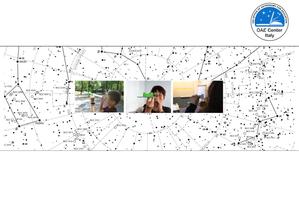Glossary term: Diamètre angulaire
Description: Le diamètre angulaire d'un objet est son diamètre visible à partir d'un endroit spécifique, mesuré sous forme d'angle. Le diamètre angulaire est utilisé en astronomie comme l'un des moyens d'exprimer la taille des objets célestes dans le ciel. Le diamètre angulaire augmente avec la taille physique de l'objet et diminue lorsque l'objet est plus éloigné. Par exemple, la Lune et le Soleil ont tous deux un diamètre angulaire d'environ un demi-degré lorsqu'ils sont vus de la Terre. La Lune est environ 400 fois plus petite que le Soleil, mais nous apparait avec la même taille (environ un demi-degré de diamètre), car le Soleil est environ 400 fois plus éloigné.
See this term in other languagesTerm and definition status: The original definition of this term in English have been approved by a research astronomer and a teacher The translation of this term and its definition is still awaiting approval
The OAE Multilingual Glossary is a project of the IAU Office of Astronomy for Education (OAE) in collaboration with the IAU Office of Astronomy Outreach (OAO). The terms and definitions were chosen, written and reviewed by a collective effort from the OAE, the OAE Centers and Nodes, the OAE National Astronomy Education Coordinators (NAECs) and other volunteers. You can find a full list of credits here. All glossary terms and their definitions are released under a Creative Commons CC BY-4.0 license and should be credited to "IAU OAE".
If you notice a factual or translation error in this glossary term or definition then please get in touch.
Related Activities
The sky at your fingertips
astroEDU educational activity (links to astroEDU website) Description: Build a simple cross-staff and measure the stars!License: CC-BY-4.0 Creative Commons Attribution 4.0 International (CC BY 4.0) icons
Age Ranges: 10-12 , 12-14 Education Level: Middle School , Primary Areas of Learning: Informal/Field Trip Related , Observation based , Project-based learning Costs: Low Cost Duration: 2 hours Skills: Analysing and interpreting data , Developing and using models








